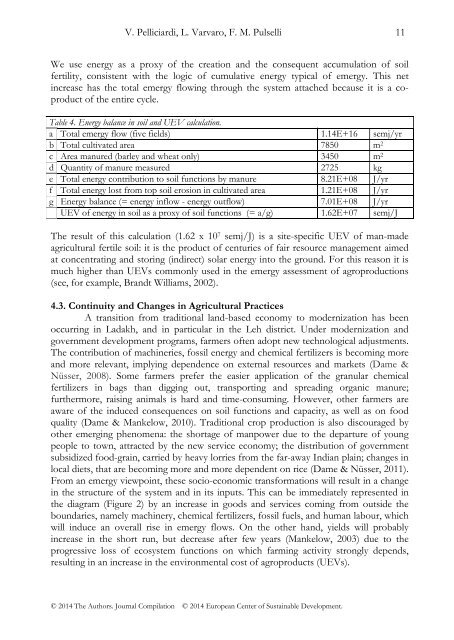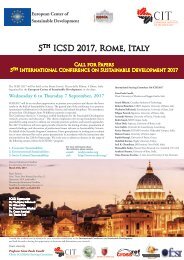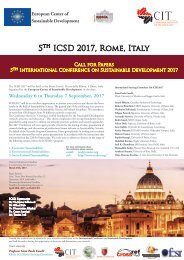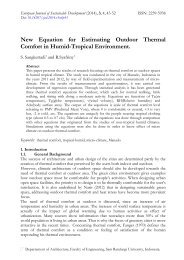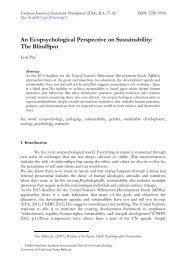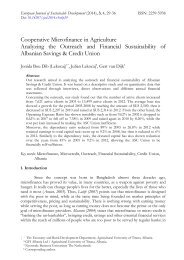Emergy evaluation of a traditional farming system. Case study: Leh District (Ladakh - Indian Trans-Himalaya)
Ladakh traditional farming system has been included on the F.A.O. list of possible “Globally Important Agricultural Heritage Systems”, worthy of being preserved and conserved. The paper describes and assesses cultivation practices in a typical familymanaged farm, located in central Ladakh, analysing how natural resources are exploited, conserved and recycled. Emergy evaluation, an environmental accounting methodology, has been applied to evaluate and compare five staple crop productions: barley, wheat, pea, mustard, and fodder alfalfa. Unit Emergy Values of products (UEV, emergy per unit product, a measure of the environmental production cost) are calculated, taking into account the inputs to production such as water from glaciers, soil fertility, human and animal labour, and more. Results show that the traditional agricultural practices in Ladakh, completely supported by renewable flows, are efficient in the use of local resources. In fact, the UEVs of agroproducts are similar to those of analogous products of conventional agriculture (e.g. 5.27E+05 and 6.64E+05 semj/J for barley and wheat in Ladakh, respectively; 7.37E+05 semj/J for corn in USA), though the inputs of Ladakh agriculture are strongly limited in type and quantity. At the same time, local farmers can create, maintain and rebuild soil functions whose UEV is 1.62E+07 semj/J. Keywords: Ladakh, agrosystem, emergy, environment, sustainability
Ladakh traditional farming system has been included on the F.A.O. list of possible “Globally Important Agricultural Heritage Systems”, worthy of being preserved and
conserved. The paper describes and assesses cultivation practices in a typical familymanaged farm, located in central Ladakh, analysing how natural resources are exploited, conserved and recycled. Emergy evaluation, an environmental accounting methodology, has been applied to evaluate and compare five staple crop productions: barley, wheat, pea, mustard, and fodder alfalfa. Unit Emergy Values of products (UEV, emergy per unit product, a measure of the environmental production cost) are calculated, taking into account the inputs to production such as water from glaciers, soil fertility, human and
animal labour, and more. Results show that the traditional agricultural practices in Ladakh,
completely supported by renewable flows, are efficient in the use of local resources. In fact, the UEVs of agroproducts are similar to those of analogous products of conventional agriculture (e.g. 5.27E+05 and 6.64E+05 semj/J for barley and wheat in Ladakh, respectively; 7.37E+05 semj/J for corn in USA), though the inputs of Ladakh agriculture are strongly limited in type and quantity. At the same time, local farmers can create, maintain and rebuild soil functions whose UEV is 1.62E+07 semj/J.
Keywords: Ladakh, agrosystem, emergy, environment, sustainability
Create successful ePaper yourself
Turn your PDF publications into a flip-book with our unique Google optimized e-Paper software.
V. Pelliciardi, L. Varvaro, F. M. Pulselli 11<br />
We use energy as a proxy <strong>of</strong> the creation and the consequent accumulation <strong>of</strong> soil<br />
fertility, consistent with the logic <strong>of</strong> cumulative energy typical <strong>of</strong> emergy. This net<br />
increase has the total emergy flowing through the <strong>system</strong> attached because it is a coproduct<br />
<strong>of</strong> the entire cycle.<br />
Table 4. Energy balance in soil and UEV calculation.<br />
a Total emergy flow (five fields) 1.14E+16 semj/yr<br />
b Total cultivated area 7850 m 2<br />
c Area manured (barley and wheat only) 3450 m 2<br />
d Quantity <strong>of</strong> manure measured 2725 kg<br />
e Total energy contribution to soil functions by manure 8.21E+08 J/yr<br />
f Total energy lost from top soil erosion in cultivated area 1.21E+08 J/yr<br />
g Energy balance (= energy inflow - energy outflow) 7.01E+08 J/yr<br />
UEV <strong>of</strong> energy in soil as a proxy <strong>of</strong> soil functions (= a/g) 1.62E+07 semj/J<br />
The result <strong>of</strong> this calculation (1.62 x 10 7 semj/J) is a site-specific UEV <strong>of</strong> man-made<br />
agricultural fertile soil: it is the product <strong>of</strong> centuries <strong>of</strong> fair resource management aimed<br />
at concentrating and storing (indirect) solar energy into the ground. For this reason it is<br />
much higher than UEVs commonly used in the emergy assessment <strong>of</strong> agroproductions<br />
(see, for example, Brandt Williams, 2002).<br />
4.3. Continuity and Changes in Agricultural Practices<br />
A transition from <strong>traditional</strong> land-based economy to modernization has been<br />
occurring in <strong>Ladakh</strong>, and in particular in the <strong>Leh</strong> district. Under modernization and<br />
government development programs, farmers <strong>of</strong>ten adopt new technological adjustments.<br />
The contribution <strong>of</strong> machineries, fossil energy and chemical fertilizers is becoming more<br />
and more relevant, implying dependence on external resources and markets (Dame &<br />
Nüsser, 2008). Some farmers prefer the easier application <strong>of</strong> the granular chemical<br />
fertilizers in bags than digging out, transporting and spreading organic manure;<br />
furthermore, raising animals is hard and time-consuming. However, other farmers are<br />
aware <strong>of</strong> the induced consequences on soil functions and capacity, as well as on food<br />
quality (Dame & Mankelow, 2010). Traditional crop production is also discouraged by<br />
other emerging phenomena: the shortage <strong>of</strong> manpower due to the departure <strong>of</strong> young<br />
people to town, attracted by the new service economy; the distribution <strong>of</strong> government<br />
subsidized food-grain, carried by heavy lorries from the far-away <strong>Indian</strong> plain; changes in<br />
local diets, that are becoming more and more dependent on rice (Dame & Nüsser, 2011).<br />
From an emergy viewpoint, these socio-economic transformations will result in a change<br />
in the structure <strong>of</strong> the <strong>system</strong> and in its inputs. This can be immediately represented in<br />
the diagram (Figure 2) by an increase in goods and services coming from outside the<br />
boundaries, namely machinery, chemical fertilizers, fossil fuels, and human labour, which<br />
will induce an overall rise in emergy flows. On the other hand, yields will probably<br />
increase in the short run, but decrease after few years (Mankelow, 2003) due to the<br />
progressive loss <strong>of</strong> eco<strong>system</strong> functions on which <strong>farming</strong> activity strongly depends,<br />
resulting in an increase in the environmental cost <strong>of</strong> agroproducts (UEVs).<br />
© 2014 The Authors. Journal Compilation © 2014 European Center <strong>of</strong> Sustainable Development.


